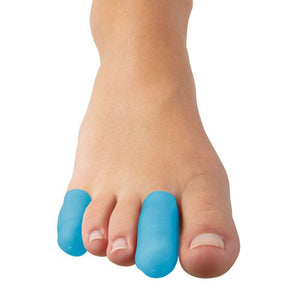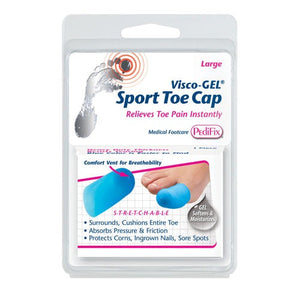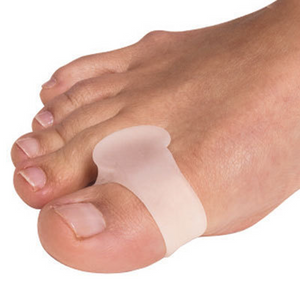An ingrown toenail can cause terrible pain and discomfort. Your toenail grows into the surrounding skin, resulting in redness, oedema, and occasionally infection. It may make it challenging to put on shoes and walk. However, there are easy ways to stop and permanently fix an ingrown toenail.
Let's talk about the causes of ingrown toenails and practical remedies.
8 Reasons You May Get Ingrown Toenail
Ingrown toenails can occur for various reasons, including:
1- Improper Nail Trimming
Nail growth into surrounding skin can occur when nails are overcut or have rounded corners.
2- Poorly Fitted Shoes
Shoes that are too small or tight might put pressure on the toes, pushing the nails into the skin.
3- Trauma
A toe stub or a heavy object dropped on it might harm the nail and lead to uneven nail growth.
4- Sweaty Feet
Sweating can cause the skin around the nail to become softer. It facilitates the nail's penetration into the skin.
5- Foot Deformities
Ingrown toenails are more likely to occur when conditions like bunions or hammertoes alter toe alignment.
6- Fungal infections
Fungal nail infections (onychomycosis can thicken and distort the nail, making it more likely to become ingrown.
7- Injury or Surgery
Previous injuries to the toe or surgical procedures on the nail can alter its growth pattern and lead to ingrown nails.
8- Poor Foot Hygiene
Ingrown toenails can result from increased bacterial or fungal infections when feet are not kept dry and clean.
Tips to Deal With Ingrown Toenail Permanently
If your feet have ingrown toenails, no worries. Just follow some tips regularly, and your toes will be renewed in no time:
1. Proper Nail Trimming
Always cut your toenails straight across while cutting them. It aids in keeping the edges from encroaching on the skin. Make use of a sharp toenail clipper.
Avoid cutting the tips of your nails off. Nail penetration into the flesh may occur from rounded corners.
Cut your nails short. After trimming, leave a small portion of the nail's white tip visible.
2. Soak Your Feet
Treating your feet becomes more manageable if you soak them in warm water. It will soften your skin and nails. 3–4 times a day, soak your feet for 15–20 minutes.
If there is an infection, add Epsom salt to the water to help drain out any pus and minimize swelling. Use one or two tablespoons of Epsom salt for every gallon of warm water.
3. Wear Proper Footwear
Wear shoes that give your toes plenty of space to move. Squeezing your toes in tight shoes or high heels can push the nails into the flesh. Choose shoes with a wide toe box to prevent pressure on your toes.
Put on cotton or other breathable socks to help keep you more relaxed and avoid becoming sick. Regularly changing your socks will help to keep your feet dry.
4. Protect Your Toes
To prevent further discomfort, bandage the affected region. You can use a tiny piece of gauze or soft padding to cushion it.
Soak your feet, then carefully lift the ingrown nail's corner. Place a little piece of cotton or dental floss under the nail edge to encourage nail growth above the skin.
To maintain the area tidy and effectively guide the nail, replace the cotton or floss on a daily basis.
5. Try Topical Antibiotics
To avoid infections, apply over-the-counter antibiotic ointments. Cleanse the afflicted area with water and mild soap before application.
Apply the ointment one or two times daily. It’s preferable after soaking your feet and before bandaging.
6. Pain Relief Methods
Acetaminophen and ibuprofen are two medications that can help control pain and inflammation. Always adhere to the dose recommendations on the packaging.
To minimize swelling and numb the pain, apply an ice pack. Apply the ice pack on the injured toe for ten to fifteen minutes after wrapping it in a cloth.
7. Avoid Trauma
Avoid activities that might injure your toes, such as kicking or stubbing them. If you play sports, wear protective footwear to avoid trauma to your toenails.
8- Use Apple Cider Vinegar
Because of its antibacterial and anti-inflammatory characteristics, apple cider vinegar can be used to treat ingrown toenails.
In a bowl, combine equal parts warm water and apple cider vinegar. Soak your foot for fifteen to twenty minutes. Repeat this twice to three times daily to help de-swell and soften the skin.
If you experience any irritation, stop applying it and give your foot a thorough water rinse.
9. Get Medical Help
See a doctor if the ingrown toenail doesn’t get better after a week of home treatment or if it keeps returning.
A doctor might prescribe more potent antibiotics or perform a minor procedure to remove part of the nail.
If you notice more redness, swelling, pus, or severe pain, seek medical attention immediately.
10. Surgical Options
In severe cases, part of the nail might need to be removed to allow it to grow back correctly. This minor procedure is usually done with local anaesthesia.
The nail matrix (the tissue under the nail that helps it grow) may need to be removed for a more permanent solution. It can prevent the nail from growing back and causing future problems.
11 Post-Surgical Care
Pay close attention to your doctor's aftercare instructions following any surgical operation. Maintain a dry and clean surgery site to avoid infection.
Refrain from applying pressure to the injured toe as it heals. Check for infection symptoms, and contact your physician if you see any.
Get Medical Aid from MoovKart!
For extra help with ingrown toenails, get toe cushions and toe spacers from MoovKart. These products can relieve pressure on your toes and help the nail grow correctly.
Visit MoovKart now to find the best solutions for your foot care needs!
People Also Ask!
Q1. Why do toenails grow inward?
A1. When the edge of your toenail grows into the skin, it becomes an ingrown toenail. Wearing tight shoes, cutting your nails too short, or getting a toe injury can all be contributing factors.
Q2. What is the home remedy for an ingrown toenail?
A2. An ingrown toenail can be treated at home by soaking the foot in warm water, lifting the nail with cotton or dental floss, and then using an antibiotic cream. See a doctor if it doesn't improve.
Q3. When should I get my ingrown toenail checked out by a doctor?
A3. You should consult a doctor if your ingrown toenails are painful, swollen, or red or if pus is visible. Also, get medical attention if it doesn't improve after a week of at-home care.







